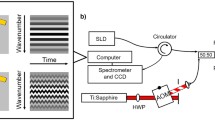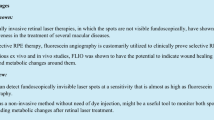Abstract
To avoid a devastating effect of eye vision impairment on the information flow from the eye to our brain, enormous effort is being put during the last decades into the development of more sensitive diagnostics and more efficient therapies of retinal tissue. While morphology can be impressively imaged by optical coherence tomography, molecular-associated pathology information can be provided almost exclusively by auto-fluorescence-based methods. Among the latter, the recently developed fluorescence lifetime imaging ophthalmoscopy (FLIO) has the potential to provide both structural information and interacting pictures at the same time. The requirements for FLIO laser sources are almost orthogonal to the laser sources used in phototherapy that is expected to follow up the FLIO diagnostics. To make theranostics more effective and cheaper, the complete system would need to couple at least the modalities of low-power high-repetition-rate FLIO and precision high-pulse energy-adjustable repetition rate phototherapy. In addition, the intermediate-power high repetition rate for two-photon excitation would also be desired to increase the depth resolution. In our work, compact fiber-laser based on high-speed gain-switched laser diode has been shown to achieve adaptable/independently tunable repetition rate and energy per pulse allowing coupled fluorescence lifetime diagnostics via two-photon excitation and phototherapy via laser-induced photodisruption on a local molecular environment in a complex ex vivo retinal tissue.





Similar content being viewed by others
References
F.C. Delori, C.K. Dorey, G. Staurenghi, O. Arend, D.G. Goger, J.J. Weiter, In vivo fluorescence of the ocular fundus exhibits retinal pigment epithelium lipofuscin characteristics. Invest. Ophthalmol. Vis. Sci. 36, 718–729 (1995)
A. von Rückmann, F.W. Fitzke, A.C. Bird, Distribution of fundus autofluorescence with a scanning laser ophthalmoscope. Br J Ophthalmol. 79, 407–412 (1995). https://doi.org/10.1136/bjo.79.5.407
A.F. Fercher, K. Mengedoht, W. Werner, Eye-length measurement by interferometry with partially coherent light. Opt. Lett. 13, 186–188 (1988). https://doi.org/10.1364/OL.13.000186
W. Drexler, U. Morgner, R.K. Ghanta, F.X. Kärtner, J.S. Schuman, J.G. Fujimoto, Ultrahigh-resolution ophthalmic optical coherence tomography. Nat. Med. 7, 502–507 (2001). https://doi.org/10.1038/86589
J. Marshall, The ageing retina: physiology or pathology. Eye. 1, 282–295 (1987). https://doi.org/10.1038/eye.1987.47
J. Sparrow, T. Duncker, J.R. Sparrow, T. Duncker, Fundus Autofluorescence and RPE Lipofuscin in age-related macular degeneration. Journal of Clinical Medicine. 3, 1302–1321 (2014). https://doi.org/10.3390/jcm3041302
J. Teister, A. Liu, D. Wolters, N. Pfeiffer, F.H. Grus, Peripapillary fluorescence lifetime reveals age-dependent changes using fluorescence lifetime imaging ophthalmoscopy in rats. Exp. Eye Res. 176, 110–120 (2018). https://doi.org/10.1016/j.exer.2018.07.008
J. Schmidt, S. Peters, L. Sauer, D. Schweitzer, M. Klemm, R. Augsten, N. Müller, M. Hammer, Fundus autofluorescence lifetimes are increased in non-proliferative diabetic retinopathy. Acta Ophthalmol. 95, 33–40 (2017). https://doi.org/10.1111/aos.13174
L. Sauer, R.H. Gensure, M. Hammer, P.S. Bernstein, Fluorescence lifetime imaging ophthalmoscopy: A novel way to assess macular telangiectasia type 2. Oph Retina. 2, 587–598 (2018). https://doi.org/10.1016/j.oret.2017.10.008
D. Schweitzer, L. Deutsch, M. Klemm, S. Jentsch, M. Hammer, S. Peters, J. Haueisen, U.A. Müller, J. Dawczynski, Fluorescence lifetime imaging ophthalmoscopy in type 2 diabetic patients who have no signs of diabetic retinopathy. JBO, JBOPFO. 20, 061106 (2015). https://doi.org/10.1117/1.JBO.20.6.061106
J.A. Feeks, J.J. Hunter, Adaptive optics two-photon excited fluorescence lifetime imaging ophthalmoscopy of exogenous fluorophores in mice. Biomed. Opt. Express. 8, 2483–2495 (2017). https://doi.org/10.1364/BOE.8.002483
C. Dysli, R. Fink, S. Wolf, M.S. Zinkernagel, Fluorescence lifetimes of drusen in age-related macular degeneration. Invest. Ophthalmol. Vis. Sci. 58, 4856–4862 (2017). https://doi.org/10.1167/iovs.17-22184
L. Sauer, C.B. Komanski, A.S. Vitale, E.D. Hansen, P.S. Bernstein, Fluorescence lifetime imaging ophthalmoscopy (FLIO) in eyes with pigment epithelial detachments due to age-related macular degeneration. Invest Ophthalmol Vis Sci. 60, 3054–3063 (2019). https://doi.org/10.1167/iovs.19-26835
D. Schweitzer, S. Schenke, M. Hammer, F. Schweitzer, S. Jentsch, E. Birckner, W. Becker, A. Bergmann, Towards metabolic mapping of the human retina. Microsc. Res. Tech. 70, 410–419 (2007). https://doi.org/10.1002/jemt.20427
C. Dysli, S. Wolf, M.Y. Berezin, L. Sauer, M. Hammer, M.S. Zinkernagel, Fluorescence lifetime imaging ophthalmoscopy. Progress in Retinal and Eye Research. 60, 120–143 (2017). https://doi.org/10.1016/j.preteyeres.2017.06.005
A. Periasamy, P. Wodnicki, X.F. Wang, S. Kwon, G.W. Gordon, B. Herman, Time-resolved fluorescence lifetime imaging microscopy using a picosecond pulsed tunable dye laser system. Rev. Sci. Instrum. 67, 3722–3731 (1996). https://doi.org/10.1063/1.1147139
A. Ehlers, I. Riemann, M. Stark, K. König, Multiphoton fluorescence lifetime imaging of human hair. Microsc. Res. Tech. 70, 154–161 (2007). https://doi.org/10.1002/jemt.20395
B. Leskovar, C.C. Lo, P.R. Hartig, K. Sauer, Photon counting system for subnanosecond fluorescence lifetime measurements. Rev. Sci. Instrum. 47, 1113–1121 (1976). https://doi.org/10.1063/1.1134827
J. Roider, S.H.M. Liew, C. Klatt, H. Elsner, E. Poerksen, J. Hillenkamp, R. Brinkmann, R. Birngruber, Selective retina therapy (SRT) for clinically significant diabetic macular edema. Graefes Arch Clin Exp Ophthalmol. 248, 1263–1272 (2010). https://doi.org/10.1007/s00417-010-1356-3
E. Seifert, J. Tode, A. Pielen, D. Theisen-Kunde, C. Framme, J. Roider, Y. Miura, R. Birngruber, R. Brinkmann, Selective retina therapy: toward an optically controlled automatic dosing. J Biomed Opt. 23, 1–12 (2018). https://doi.org/10.1117/1.JBO.23.11.115002
S. Al-Hussainy, P.M. Dodson, J.M. Gibson, Pain response and follow-up of patients undergoing panretinal laser photocoagulation with reduced exposure times. Eye 22, 96–99 (2008). https://doi.org/10.1038/sj.eye.6703026
S.V. Reddy, D. Husain, Panretinal Photocoagulation: A Review of Complications. Semin Ophthalmol 33, 83–88 (2018). https://doi.org/10.1080/08820538.2017.1353820
R.H. Guymer, Z. Wu, L.A.B. Hodgson, E. Caruso, K.H. Brassington, N. Tindill, K.Z. Aung, M.B. McGuinness, E.L. Fletcher, F.K. Chen, U. Chakravarthy, J.J. Arnold, W.J. Heriot, S.R. Durkin, J.J. Lek, C.A. Harper, S.S. Wickremasinghe, S.S. Sandhu, E.K. Baglin, P. Sharangan, S. Braat, C.D. Luu, Laser Intervention In Early Stages Of Age-Related Macular Degeneration Study Group, Subthreshold Nanosecond Laser Intervention In Age-Related Macular Degeneration: The LEAD randomized controlled clinical trial. Ophthalmology 126, 829–838 (2019). https://doi.org/10.1016/j.ophtha.2018.09.015
W.R. Calhoun, I.K. Ilev, Effect of therapeutic femtosecond laser pulse energy, repetition rate, and numerical aperture on laser-induced second and third harmonic generation in corneal tissue. Lasers Med. Sci. 30, 1341–1346 (2015). https://doi.org/10.1007/s10103-015-1726-5
Z. Hu, H. Zhang, A. Mordovanakis, Y.M. Paulus, Q. Liu, X. Wang, X. Yang, High-precision, non-invasive anti-microvascular approach via concurrent ultrasound and laser irradiation. Sci. Rep. 7, 40243 (2017). https://doi.org/10.1038/srep40243
J.P.M. Wood, O. Shibeeb, M. Plunkett, R.J. Casson, G. Chidlow, Retinal damage profiles and neuronal effects of laser treatment: comparison of a conventional photocoagulator and a novel 3-nanosecond pulse laser. Invest. Ophthalmol. Vis. Sci. 54, 2305–2318 (2013). https://doi.org/10.1167/iovs.12-11203
Y. Takatsuna, S. Yamamoto, Y. Nakamura, T. Tatsumi, M. Arai, Y. Mitamura, Long-term therapeutic efficacy of the subthreshold micropulse diode laser photocoagulation for diabetic macular edema. Jpn. J. Ophthalmol. 55, 365–369 (2011). https://doi.org/10.1007/s10384-011-0033-3
G. Schuele, H. Elsner, C. Framme, J. Roider, R. Birngruber, R. Brinkmann, Optoacoustic real-time dosimetry for selective retina treatment. JBO, JBOPFO. 10, 064022 (2005). https://doi.org/10.1117/1.2136327
Y.M. Paulus, A. Jain, H. Nomoto, C. Sramek, R.F. Gariano, D. Andersen, G. Schuele, L.-S. Leung, T. Leng, D. Palanker, Selective retinal therapy with microsecond exposures using a continuous line scanning laser. Retina 31, 380 (2011). https://doi.org/10.1097/IAE.0b013e3181e76da6
R.R. Anderson, J.A. Parrish, Selective photothermolysis: precise microsurgery by selective absorption of pulsed radiation. Science 220, 524–527 (1983). https://doi.org/10.1126/science.6836297
W.T. Ham, R.C. Williams, H.A. Mueller, D. Guerry, A.M. Clarke, W.J. Geeraets, Effects of laser radiation on the mammalian eye*†. Trans. N. Y. Acad. Sci. 28, 517–526 (1966). https://doi.org/10.1111/j.2164-0947.1966.tb02368.x
J. Petelin, B. Podobnik, R. Petkovšek, Burst shaping in a fiber-amplifier chain seeded by a gain-switched laser diode. Appl. Opt. 54, 4629–4634 (2015). https://doi.org/10.1364/AO.54.004629
M. Šajn, J. Petelin, V. Agrež, M. Vidmar, R. Petkovšek, DFB diode seeded low repetition rate fiber laser system operating in burst mode. Opt. Laser Technol. 88, 99–103 (2017). https://doi.org/10.1016/j.optlastec.2016.09.006
W. Becker, Advanced Time-Correlated Single Photon Counting Techniques, Springer-Verlag, Berlin Heidelberg, 2005. //www.springer.com/la/book/9783540260479. Accessed September 6, 2018.
J.P.M. Wood, M. Plunkett, V. Previn, G. Chidlow, R.J. Casson, Nanosecond pulse lasers for retinal applications. Lasers Surg. Med. 43, 499–510 (2011). https://doi.org/10.1002/lsm.21087
B. Považay, R. Brinkmann, M. Stoller, R. Kessler, Selective Retina Therapy, in High resolution imaging in microscopy and ophthalmology: New frontiers in biomedical optics, ed. by J.F. Bille (Springer, Cham, 2019), pp. 237–259. https://doi.org/10.1007/978-3-030-16638-0_11
W. Denk, J.H. Strickler, W.W. Webb, Two-photon laser scanning fluorescence microscopy. Science 248, 73–76 (1990). https://doi.org/10.1126/science.2321027
I. Saytashev, R. Glenn, G.A. Murashova, S. Osseiran, D. Spence, C.L. Evans, M. Dantus, Multiphoton excited hemoglobin fluorescence and third harmonic generation for non-invasive microscopy of stored blood. Biomed Opt Express. 7, 3449–3460 (2016). https://doi.org/10.1364/BOE.7.003449
NAD(P)H fluorescence lifetime measurements in fixed biological tissues. - PubMed - NCBI, (n.d.). https://www.ncbi.nlm.nih.gov/pubmed/31553966. Accessed March 17, 2020.
D. Schweitzer, E.R. Gaillard, J. Dillon, R.F. Mullins, S. Russell, B. Hoffmann, S. Peters, M. Hammer, C. Biskup, Time-resolved autofluorescence imaging of human donor retina tissue from donors with significant extramacular drusen. Invest. Ophthalmol. Vis. Sci. 53, 3376–3386 (2012). https://doi.org/10.1167/iovs.11-8970
G. Keiser, Light-tissue interactions, in Biophotonics: Concepts to applications, ed. by G. Keiser (Springer, Singapore, 2016), pp. 147–196. https://doi.org/10.1007/978-981-10-0945-7_6
E. Dimitrow, I. Riemann, A. Ehlers, M.J. Koehler, J. Norgauer, P. Elsner, K. König, M. Kaatz, Spectral fluorescence lifetime detection and selective melanin imaging by multiphoton laser tomography for melanoma diagnosis. Exp. Dermatol. 18, 509–515 (2009). https://doi.org/10.1111/j.1600-0625.2008.00815.x
M.F.G. Wood, N. Vurgun, M.A. Wallenburg, I.A. Vitkin, Effects of formalin fixation on tissue optical polarization properties. Phys. Med. Biol. 56, N115–N122 (2011). https://doi.org/10.1088/0031-9155/56/8/N01
M.A. Mainster, G.T. Timberlake, R.H. Webb, G.W. Hughes, Scanning laser ophthalmoscopy. Clin. Appl. Ophthalmol. 89, 852–857 (1982). https://doi.org/10.1016/s0161-6420(82)34714-4
Acknowledgements
The work was primarily carried out in the framework of the GOSTOP program, which is partially financed by the Republic of Slovenia – Ministry of Education, Science and Sport, and the European Union – European Regional Development Fund, as well as in the framework of L7-7561 Project, which is financed by the Slovenian Research Agency ARRS. In addition, this work was also partially supported by other projects of the Slovenian Research Agency ARRS (L2-9240, L2-9254, P2-0270, P1-0060). We would like to acknowledge also the group of prof. B. Drnovšek Olup on the Department of Ophthalmology of the University Medical Clinical Centre Ljubljana to provide us the access to the ex vivo samples of the retinal tissue.
Author information
Authors and Affiliations
Corresponding author
Additional information
Publisher's Note
Springer Nature remains neutral with regard to jurisdictional claims in published maps and institutional affiliations.
Rights and permissions
About this article
Cite this article
Podlipec, R., Mur, J., Petelin, J. et al. Two-photon retinal theranostics by adaptive compact laser source. Appl. Phys. A 126, 405 (2020). https://doi.org/10.1007/s00339-020-03587-2
Received:
Accepted:
Published:
DOI: https://doi.org/10.1007/s00339-020-03587-2




